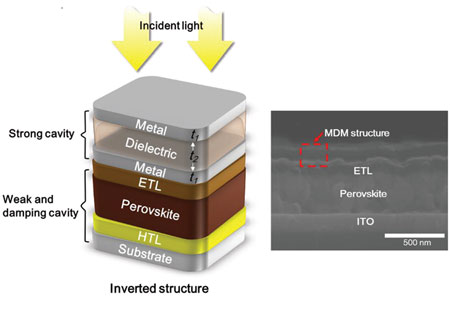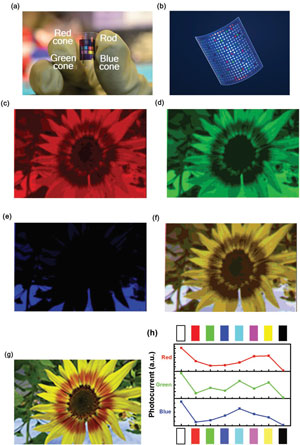| May 01, 2019 | |
On route to artificial retinas with microcavity perovskite photoreceptors |
|
| (Nanowerk Spotlight) The human retina is a film-shaped tissue behind the vitreous body in the eye. When light enters the eye and hits the retina, several layers of rod- and cone-shaped neural cells – called photoreceptors – absorb the photons with visible light wavelengths and send corresponding electric signals through the optic nerve to the brain. Rods, which are more sensitive at low light levels than cones, provide black-and-white vision. Cones are active at higher light levels and are responsible for our color vision. They come in three types, each sensitive to different wavelengths (short, medium and long). | |
| Sensory substitution with flexible electronics is one of the intriguing fields of research that takes place in nanotechnology labs around the world. Scientists already fabricate electronic devices that can replicate, to a certain degree degree, some of the human senses – touch (electronic skin – e-skin), smell (e-nose), and taste (e-tongue). | |
| Electronic device versions of the eye's photoreceptors (e-retinas) could potentially be used in a wide range of applications from robotic humanoid vision to artificial retina implantation for vision restoration or even vision extension into a wider range of wavelength. | |
| "The monolithic realization of an artificial retina that can successfully mimic the spectral responses of rods and of all three types of cones, and can provide compatible weak-light sensitivity, short response time, and large dynamic range is very challenging," Professor Hao-Wu Lin, who leads the Advanced Optoelectronic Materials Research Group at National Tsing Hua University in Taiwan, explains to Nanowerk. | |
| Special optical layers, called color filters, have been utilized to facilitate the spectral response tuning of photosensors. The integration of these optical filters, though, is expensive and complicated, especially in flexible and curved devices. | |
| Lin and his team have now demonstrated that high-performance filterless artificial human photoreceptors can be realized by integrating a novel optical metal/dielectric/metal microcavity structure with vacuum-deposited perovskite photoresponse devices. | |
 |
|
| Schematic and cross-sectional SEM image of the photoreceptor with an inverted structure. (Reprinted with permission by Wiley-VCH Verlag) | |
| The researchers reported their findings in Advanced Materials ("Band Tunable Microcavity Perovskite Artificial Human Photoreceptors"). | |
| "We successfully combined high-performance vacuum-deposited perovskite photoresponse devices with vacuum-deposited optical microcavity structures that, for the first time, realize multi-color photoreceptors on a single substrate with a single pump-down vacuum process," notes Lin. "These easy-to-fabricate artificial photoresponse devices truthfully mimic the spectral responses of human color cones and rods." | |
| As the team demonstrates in their work, the artificial photoreceptors show excellent performance similar to human eyes such as high dynamic range and low noise. Some characteristics, such as response time, even out-perform biological human photoreceptors. The devices exhibited a high stability and retained their original photocurrent values under continuous illumination of 5000 lux for 48 hours. | |
 |
|
| a,b) Photograph and virtual illustration of the integrated photoreceptors on the flexible substrate. c?e) Corresponding red, green, and blue images obtained by conducting a 2D scanning by moving the photodetectors across the photograph. f) Reconstructed sunflower image obtained by merging the red, green, and blue images. g) Original photograph of a sunflower. h) Photocurrent signals measured by moving the red, green, and blue devices across the different colored stripes (upper ones) and the reconstructed images of stripes (lower ones). (Reprinted with permission by Wiley-VCH Verlag) (click on image to enlarge) | |
| Lin points out that the resolution of the reproduced image was determined and limited by a mask of a size of 0.5 ? 0.5 mm2, which can be significantly improved using a higher resolution fine shadow mask technology (such as developed for high-resolution vacuum-deposited OLED displays) and fine pixelization of the device. | |
| Lin says that, owing to the versatile vacuum-deposited microcavity structure and the high-performance vacuum-deposited perovskite devices, it is also quite easy to fabricate artificial photoreceptors of other animals like birds (birds have four types of cone cells that extend the response to the ultraviolet range). | |
| "Those devices may one day help us understand mechanisms of the wide variety of the animal vision," he adds. | |
| Although it will be quite a long road before this kind of e-retina could be interfaced with a human brain, the researchers believe that their devices are very suitable to be used in robotic eyes. The flexible nature of the devices ensures the possibility of a curved image sensing array that can easily provide a non-distorted image with a single lens system (just like the human eye). | |
 By
Michael
Berger
– Michael is author of three books by the Royal Society of Chemistry:
Nano-Society: Pushing the Boundaries of Technology,
Nanotechnology: The Future is Tiny, and
Nanoengineering: The Skills and Tools Making Technology Invisible
Copyright ©
Nanowerk LLC
By
Michael
Berger
– Michael is author of three books by the Royal Society of Chemistry:
Nano-Society: Pushing the Boundaries of Technology,
Nanotechnology: The Future is Tiny, and
Nanoengineering: The Skills and Tools Making Technology Invisible
Copyright ©
Nanowerk LLC
|
|
|
Become a Spotlight guest author! Join our large and growing group of guest contributors. Have you just published a scientific paper or have other exciting developments to share with the nanotechnology community? Here is how to publish on nanowerk.com. |
|
